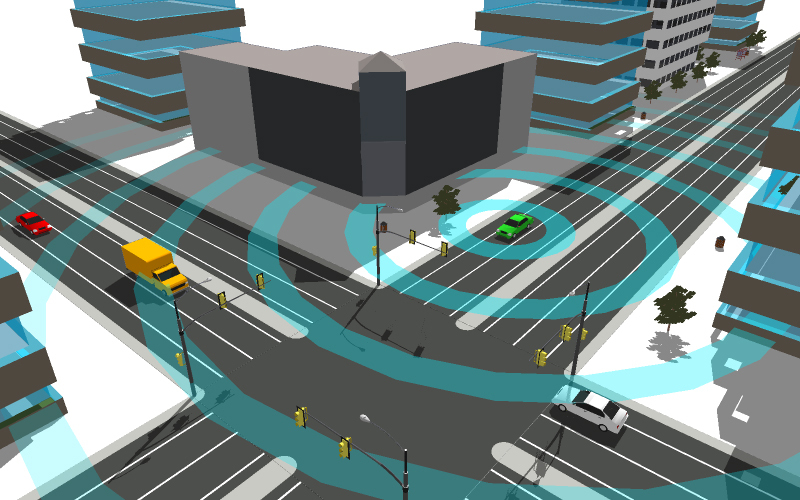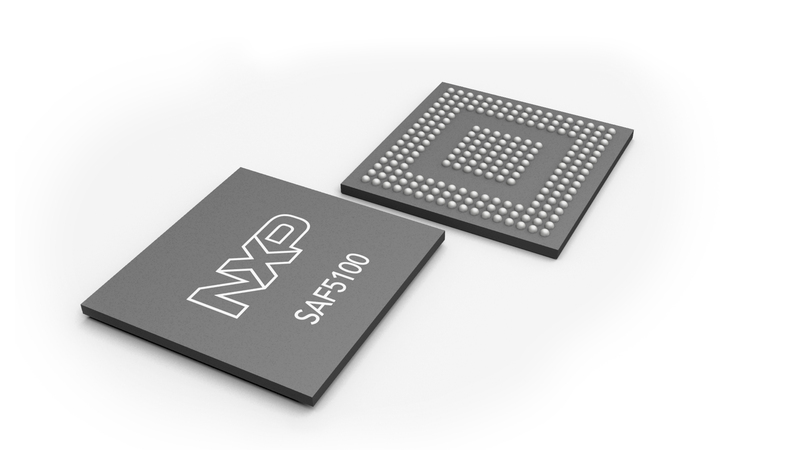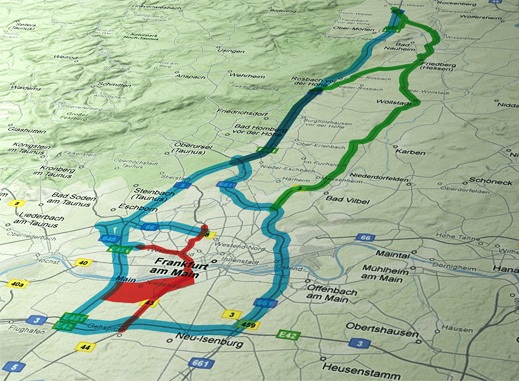Connected Cars
Cars will have the ability to communicate autonomously in the near future to improve road users’ safety. Sally Ward-Foxton explores car-to-car and car-to-infrastructure technology.
Today’s cars are full of safety features but none have so far managed to completely stop all accidents. While we wait for driverless cars to become a reality, Advanced Driver Assistance Systems (ADAS) are helping drivers spot hazards immediately as they occur, or even before they do, using sophisticated electronics. A new twist on this idea is car-to-car communications (C2C), which involves vehicles communicating with each other to share their position, speed, hazard light status and other data that can help prevent accidents. This data can be presented to the driver to improve awareness and warn of potential hazards ahead (Figure 1).

Figure 1: C2C and C2I communications could help prevent accidents by alerting the driver to potential hazards
An in-vehicle system would analyse the incoming data and pass that information to the driver (Figure 2). Collision warnings, perhaps when changing lanes, could be audibly sounded or displayed on the dashboard.
Cars may also communicate with things like traffic lights and other signage via car-to-infrastructure communications (C2I; C2C and C2I are often called C2X). C2I has many potential uses including easing traffic congestion. For example, the car could communicate with variable road speed limit signs to display the current speed limit on the dashboard. Or in the event of an accident, the car could communicate its position and nature of the accident with police and the emergency services, while communicating with cars around it that it has stopped and is therefore a potential hazard.
Wireless technology
C2X communications are based on the IEEE’s 802.11p standard, designed especially for intelligent transportation systems (ITS). The main features of this standard include low latency communication, so cars can transmit information like their position and speed up to ten times a second. It operates in the 5.9GHz band, capable of transmitting data over long distances and without line of sight; features that are obviously crucial for this application. It can therefore provide information that radar and cameras can’t.
Successful trials of the technology, like Germany’s SimTD project and the SCORE@F trial in France, have relied on NXP’s RoadLINK series of software defined radio processors for this application. NXP worked with Australian RF experts Cohda Wireless to develop the latest member of this family, the SAF5100 (Figure 2). This programmable SoC supports both 802.11p and 802.11abgn (WiFi) wireless standards so it can upload and access data via WiFi hotspot connections; multiple streams are also possible for non-safety-related transmissions such as DAB, DRM, DVB-T, etc.
.jpg)
Figure 2: An in-vehicle system would analyse incoming data and pass information to the driver. This setup is from the SimTD trial (see below)
However, this isn’t your average consumer WiFi chip. It has to have superior wireless performance to transmit and receive data reliably between two objects travelling at 80 mph in opposite directions.
“Transmitting and receiving data between objects travelling quickly and in opposite directions is by no means easy, but is feasible and possible at speeds of 80 mph and even above,” says Thomas Hinz, Senior Product Marketing Manager for C2X solutions at NXP. “With the current technology available to us, a range of 1 mile and more is achievable but this is highly dependent on the surrounding environmental conditions.”
In areas such as cities, the range can be limited due to tall buildings and other signal obstructions, but the trials show very high safety message success rate during highway travelling conditions (safe highway driving distance at 90 km/h). Differentiating algorithms compensate for artefacts like Doppler spread to enhance signal reception.
Other features include low power operation — less than 1W — and support for other ITS communication standards like those for electronic toll collection. Being programmable, the device can be reprogrammed in the field to support different global standards or accept updates. It is suitable for both vehicles and traffic infrastructure.
Security and Reliability
Since C2X systems are essentially safety systems, reliability is of the utmost importance. It’s still too early to subject C2C and C2I systems to the automotive safety standard ISO 26262 but Hinz says this may happen in the future.
“This is clearly subject to the OEM requirements, but it is likely that initially C2C and C2I deployments will start as non-intrusive functions without being subject to ISO 26262,” Hinz says. “If C2X systems become part of the automated driving in the future this might change and appropriate ASIL levels for the system might come into play.”
Security is also a fundamental consideration. Any attempt to tamper with the signals, malicious or otherwise, could have disastrous results. For this reason, Hinz explains that techniques have been developed for verifying the message before releasing any warning signals; these include hardware cryptographic accelerators, anti-counterfeiting and anti-theft measures, and signed messages.
The success of any C2X network will also depend on compatibility. Different brands and vehicles must be able to communicate; it wouldn’t work if a BMW couldn’t talk to a Mercedes or a motorcycle couldn’t talk to a lorry. If this technology is to be adopted globally, international networks need to be aligned, or at the very least, compatible.
The Car 2 Car Communication Consortium has been set up to govern the implementation of car-to-car communications worldwide, ensuring compatibility between brands and recognising the need for customised software for the US, European and Japanese markets. Differences such as driving on the opposite side of the road and different traffic laws must of course be taken into account for these different regions. A memorandum of understanding (MoU), signed by members including 12 vehicle manufacturers, aims to harmonise technology for the deployment of C2X systems globally. This MoU also commits the manufacturers to the prescribed technical specifications, like message formats and timing, as well as security requirements as per EU Mandate M/453.
For its part, NXP’s programmable solution supports different countries’ firmware, plus antenna configurations like 802.11p antenna diversity.
“As standards differ depending on region, the SAF5100 can support protocols for Europe as well as for the US and also for Japan based on the same hardware platform,” says Hinz. “This software defined radio technology is also providing OEMs with the flexibility to support emerging standards across multiple regions via firmware updates.”

Figure 3: NXP’s SAF5100 is a software defined radio processor which supports both 802.11p and WiFi; multiple streams are possible for non-safety-related transmissions such as DAB, DRM, DVB-T, etc.
So, how soon can we expect to be buying a car with the capability to communicate with the car in front and the next set of traffic lights? The good news is that Europe is taking the lead on this one.
“We can expect C2C and C2I technology to be rolled out in EMEA in 2015/2016,” according to Hinz. “Japan is also expected to commence deployment from 2015 on, and the US’ position will be confirmed depending on a mandate,” he adds.
Trialling the Technology
The SimTD trials in Frankfurt, Germany have been the most comprehensive C2X trials to date, including several hundred roadside stations and a 120-strong test fleet of enabled vehicles (including 3 motorcycles). The test fleet was driven by a combination of some expert drivers and some drivers with no special training. The technology was tested on actual roads in real conditions (Figure 4) and on different types of road.

Figure 4: The span of the SimTD trial. The motorway sections are shown in blue, rural road sections in green and inner-city roads in red
The general focus of the tests were to monitor the general traffic and weather situation, but the different road types had additional criteria. The rural roads were used for testing systems for obstacle warning and information on roadworks, while the urban scenario focussed on traffic light control. The motorways were divided into two sections with different densities of roadside stations; the emphasis here was on traffic forecasting to avoid traffic jams.
Overall, the trial was deemed extremely successful, clocking up 1.65 million km over 41,000 hours. The group behind the trial says full adoption of this system could save 6.5 billion Euros a year from traffic accidents, plus a macroeconomic benefit of 4.9 billion Euros resulting from fuel efficiency and reduced emissions.
So, how soon can we expect to be buying a car with the capability to communicate with the car in front and the next set of traffic lights? The good news is that Europe is taking the lead on this one.



